Residual Forest Biomass in Pinus Stands: Accumulation and Biogas Production Potential
Abstract
:1. Introduction
2. Materials and Methods
2.1. Site and Field Work
2.2. Forest Biomass Samples and Pre-Treatment
2.3. Batch Anaerobic Digestion Assays
- rS = substrate consumption rate (kg VS m−3 d−1)
- K = first-order kinetic constant (d−1)
- S = substrate concentration (kg VS m−3)
3. Results
4. Discussion
- YCH4/km = methane yield per km of forest road (Nm3 km−1)
- YCH4/VS = methane yield per kg VS of pine needle litter (Nm3 kg−1 VS)
- VS = pine needle litter VS content (kg VS kg−1 FM)
- d = pine needle litter bulk density (kg m−2)
- w = vertical distance of pine needle litter accumulation on adjacent forest road (m)
5. Conclusions
Author Contributions
Funding
Institutional Review Board Statement
Informed Consent Statement
Conflicts of Interest
References
- Xu, N.; Liu, S.; Xin, F.; Zhou, F.; Jia, H.; Xu, J.; Jiang, M.; Dong, W. Biomethane Production from Lignocellulose: Biomass Recalcitrance and Its Impacts on Anaerobic Digestion. Front. Bioeng. Biotechnol. 2019, 7, 191. [Google Scholar] [CrossRef] [PubMed]
- Dahmen, N.; Lewandowski, I.; Zibek, S.; Weidtmann, A. Integrated lignocellulosic value chains in a growing bioeconomy: Status quo and perspectives. GCB Bioenergy 2018, 11, 107–117. [Google Scholar] [CrossRef] [Green Version]
- Dahunsi, S.O.; Enyinnaya, M. The bioenergy potentials of Lignocelluloses. In Energy Conversion: Current Technologies and Future Trends; Al-Bahadly, I.H., Ed.; InTechOpen: London, UK, 2018; pp. 93–104. [Google Scholar] [CrossRef] [Green Version]
- Dhyani, V.; Bhaskar, T. A comprehensive review on the pyrolysis of lignocellulosic biomass. Renew. Energy 2018, 129, 695–716. [Google Scholar] [CrossRef]
- Canabarro, N.; Soares, J.F.; Anchieta, C.G.; Kelling, C.; Mazutti, M.A. Thermochemical processes for biofuels production from biomass. Sustain. Chem. Process. 2013, 1, 22. [Google Scholar] [CrossRef] [Green Version]
- Nanda, S.; Kozinski, A.J.; Dalai, K.A. Lignocellulosic biomass: A review of conversion technologies and fuel products. Curr. Biochem. Eng. 2016, 3, 24–36. [Google Scholar] [CrossRef]
- Zadeh, E.Z.; Abdulkhani, A.; Aboelazayem, O.; Saha, B. Recent insights into lignocellulosic biomass pyrolysis: A critical review on pretreatment, characterization, and products upgrading. Processes 2020, 8, 799. [Google Scholar] [CrossRef]
- Nielsen Sander, B. Offsetting methane emissions from agriculture. In Proceedings of the European Biogas Conference, EBA, Brussels, Belgium, 26–27 October 2021. [Google Scholar]
- Elsayed, M.; Blel, W.; Soliman, M.; Andres, Y.; Hassan, R. Semi-continuous co-digestion of sludge, fallen leaves, and grass performance. Energy 2021, 221, 119888. [Google Scholar] [CrossRef]
- Klavins, A.; Dubrocskis, V.; Plume, I. Effectiveness of usage of straw and oak leave pellets for biogas production. Eng. Rur. Dev. 2020, 2020, 1900–1906. [Google Scholar] [CrossRef]
- Mu, L.; Zhang, L.; Ma, J.; Zhu, K.; Chen, C.; Li, A. Enhancement of anaerobic digestion of phoenix tree leaf by mild alkali pretreatment: Optimization by Taguchi orthogonal design and semi-continuous operation. Bioresour. Technol. 2020, 313, 123634. [Google Scholar] [CrossRef]
- Kantartzis, A.; Daoutis, C.; Eftaxias, A.; Arabatzis, G.; Diamantis, V. Biomass residues adjacent forest roads in two different forest species (Fagus sylvatica and Pinus brutia): Quantities and evaluation of their biogas production potential. IOP Conf. Ser. Earth Environ. Sci. 2021, 899, 012030. [Google Scholar] [CrossRef]
- Vivenkanand, V.; Olsen, E.F.; Eijsink, V.G.H.; Horn, S.J. Effect of different steam explosion conditions on methane potential and enzymatic saccharification of birch. Bioresour. Technol. 2013, 127, 343–349. [Google Scholar] [CrossRef] [PubMed]
- Yao, Y.; He, M.; Ren, Y.; Ma, L.; Luo, Y.; Sheng, H.; Xiang, Y.; Zhang, H.; Li, Q.; An, L. Anaerobic digestion of poplar processing residues for methane production after alkaline treatment. Bioresour. Technol. 2013, 134, 347–352. [Google Scholar] [CrossRef] [PubMed]
- Brown, D.; Shi, J.; Li, Y. Comparison of solid-state to liquid anaerobic digestion of lignocellulosic feedstocks for biogas production. Bioresour. Technol. 2012, 124, 379–386. [Google Scholar] [CrossRef]
- Rasi, S.; Kilpelainen, P.; Rasa, K.; Korpinen, R.; Raitanen, J.E.; Vainio, M.; Kitunen, V.; Pulkkinen, H.; Jyske, T. Cascade processing of softwood bark with hot water extraction, pyrolysis and anaerobic digestion. Bioresour. Technol. 2019, 292, 121893. [Google Scholar] [CrossRef] [PubMed]
- Salehian, P.; Karimi, K. Alkali pretreatment for improvement of biogas and ethanol production from different waste parts of pine tree. Ind. Eng. Chem. Res. 2012, 52, 972–978. [Google Scholar] [CrossRef]
- Isikgor, H.F.; Becer, R. Lignocellulosic biomass: A sustainable platform for the production of bio-based chemicals and polymers. Polym. Chem.-UK 2015, 6, 4497–4559. [Google Scholar] [CrossRef] [Green Version]
- Sayara, T.; Sánchez, A. A Review on Anaerobic Digestion of Lignocellulosic Wastes: Pretreatments and Operational Conditions. Appl. Sci. 2019, 9, 4655. [Google Scholar] [CrossRef] [Green Version]
- Ayanz, M.S.J.; Schulte, E.; Schmuck, G.; Camia, A.; Strobl, P.; Liberta, G.; Giovando, C.; Boca, R.; Sedano, F.; Kempeneers, P.; et al. Comprehensive monitoring of wildfires in Europe: The European Forest Fire Information System (EFFIS). In Approaches to Managing Disaster-Assessing Hazards, Emergencies and Disaster Impacts; Tiefenbacher, J., Ed.; InTechOpen: London, UK, 2012; pp. 87–108. [Google Scholar] [CrossRef] [Green Version]
- Rijo, B.; Soares Dias, A.P.; Ramos, M.; Ameixa, M. Valorization of forest waste biomass by catalyzed pyrolysis. Energy 2021, 243, 122766. [Google Scholar] [CrossRef]
- Rice, E.W.; Baird, R.B.; Eaton, A.D. Standard Methods for the Examination of Water and Wastewater; American Public Health Association (APHA), American Water Works Association, Water Environment Federation: Washington, DC, USA, 1999. [Google Scholar]
- Eftaxias, A.; Diamantis, V.; Michailidis, C.; Stamatelatou, K.; Aivasidis, A. The role of emulsification as pre-treatment on the anaerobic digestion of oleic acid: Process performance, modeling and sludge metabolic properties. Biomass Conv. Bioref. 2021, 11, 251–260. [Google Scholar] [CrossRef]
- Choung, Y.; Lee, J.; Cho, S.; Noh, J. Review on the succession process of Pinus densiflora forests in South Korea: Progressive and disturbance-driven succession. J. Ecol. Environ. 2020, 44, 16. [Google Scholar] [CrossRef]
- Rodriguez- Vallejo, C.; Navarro-Cerrillo, M.R.; Manzanedo, D.R.; Rodriguez, P.G.; Gazol, A.; Camarrero, J.J. High resilience, but low viability, of pine plantations in the face of a shift towards a drier climate. For. Ecol. Manag. 2021, 479, 118537. [Google Scholar] [CrossRef]
- Sánchez-Salguero, R.; Camarero, J.J.; Dobbertin, M.; Fernández-Cancio, A.; Vilà-Cabrera, A.; Manzanedo, R.D.; Zavala, M.A.; Navarro-Cerrillo, R.M. Contrasting vulnerability and resilience to drought-induced decline of densely planted vs. natural rear-edge Pinus. nigra forests. For. Ecol. Manag. 2013, 310, 956–967. [Google Scholar] [CrossRef]
- Zeng, X.; Wei, C.; Liu, X.; Zhang, L. Qinghai spruce (Picea crassifolia) and Chinese pine (Pinus tabuliformis) show high vulnerability and similar resilience to early- growing- season drought in the Helan Mountains, China. Ecol. Indic. 2020, 110, 105871. [Google Scholar] [CrossRef]
- Sidor, G.C.; Camarero, J.; Popa, I.; Badea, O.; Apostol, N.E.; Vlad, R. Forest vulnerability to extreme climatic events in Romanian Scots pine forests. Sci. Total Environ. 2019, 678, 721–727. [Google Scholar] [CrossRef]
- Sanseverino-Gofrin, V.; Garbolino, E.; Hinojos-Mendoza, G. Evolution of the legal prevention measures concerning forest fire risk in a context of climate change. Saf. Sci. 2017, 97, 73–80. [Google Scholar] [CrossRef]
- Moghli, A.; Santana, M.V.; Soliveres, S.; Jaime Baeza, M. Thinning and plantation of resprouting species redirect overstocked pine stands towards more functional communities in the Mediterranean basin. Sci. Total Environ. 2022, 806, 150715. [Google Scholar] [CrossRef]
- Kizha, A.R.; Han, H.S. Processing and sorting forest residues: Cost, productivity and managerial impacts. Biomass Bioenergy 2016, 93, 97–106. [Google Scholar] [CrossRef] [Green Version]
- Jones, G.; Loeffler, D.; Calkin, D.; Chung, W. Forest treatment residues for thermal energy compared with disposal by onsite burning: Emissions and energy return. Biomass Bioenergy 2010, 34, 737–746. [Google Scholar] [CrossRef]
- Panigrahi, S.; Sharma, H.B.; Tiwari, B.R.; Krishna, N.V.; Ghangerkar, M.M.; Dubey, B.K. Insight into understanding the performance of electrochemical pretreatment on improving anaerobic biodegradability of yard waste. Renew. Energy 2021, 180, 1166–1178. [Google Scholar] [CrossRef]
- Yao, Y.; Chen, S.; Kafle, G.K. Importance of “weak-base” poplar wastes to process performance and methane yield in solid-state anaerobic digestion. J. Environ. Manag. 2017, 193, 423–429. [Google Scholar] [CrossRef]
- Vlachokostas, C.; Achillas, A.; Diamantis, V.; Michailidou, A.V.; Baginetas, K.; Aidonis, D. Supporting decision making to achieve circularity via a biodegradable waste-to-bioenergy and compost facility. J. Environ. Manag. 2021, 285, 112215. [Google Scholar] [CrossRef] [PubMed]
- Diamantis, V.; Eftaxias, A.; Stamatelatou, K.; Noutsopoulos, C.; Vlachokostas, C.; Aivasidis, A. Bioenergy in the era of circular economy: Anaerobic digestion technological solutions to produce biogas from lipid-rich wastes. Renew. Energy 2021, 168, 438–447. [Google Scholar] [CrossRef]
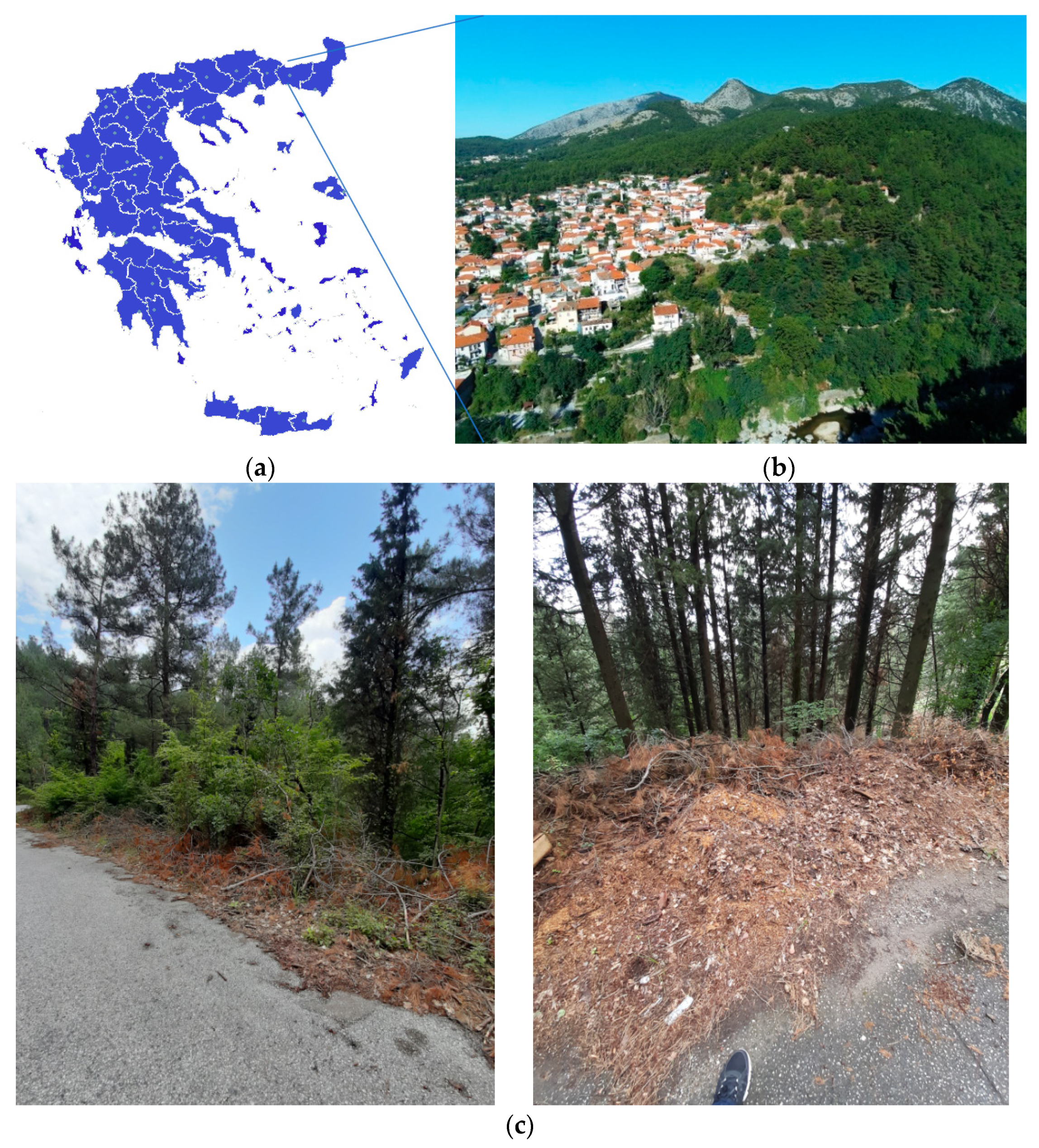

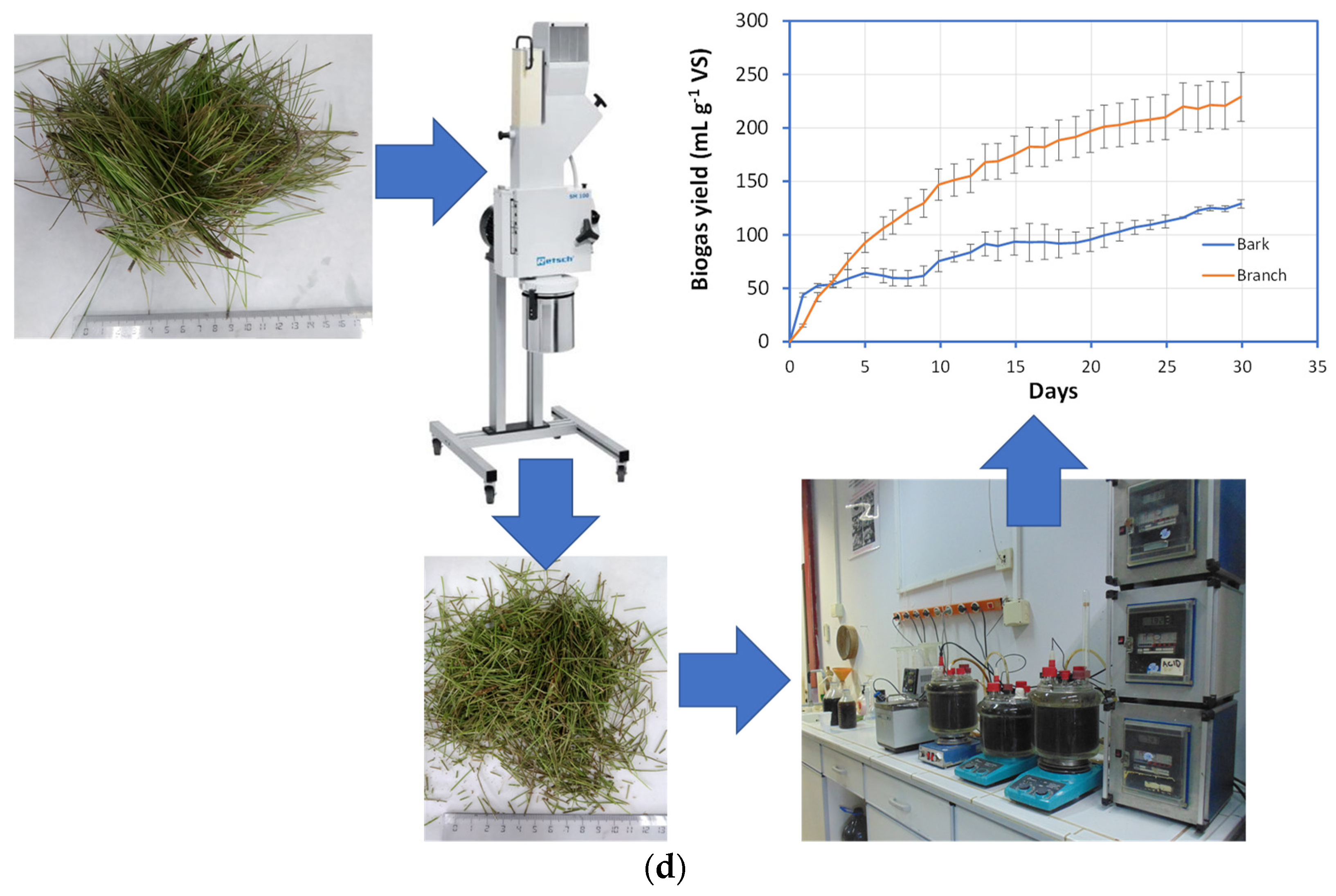


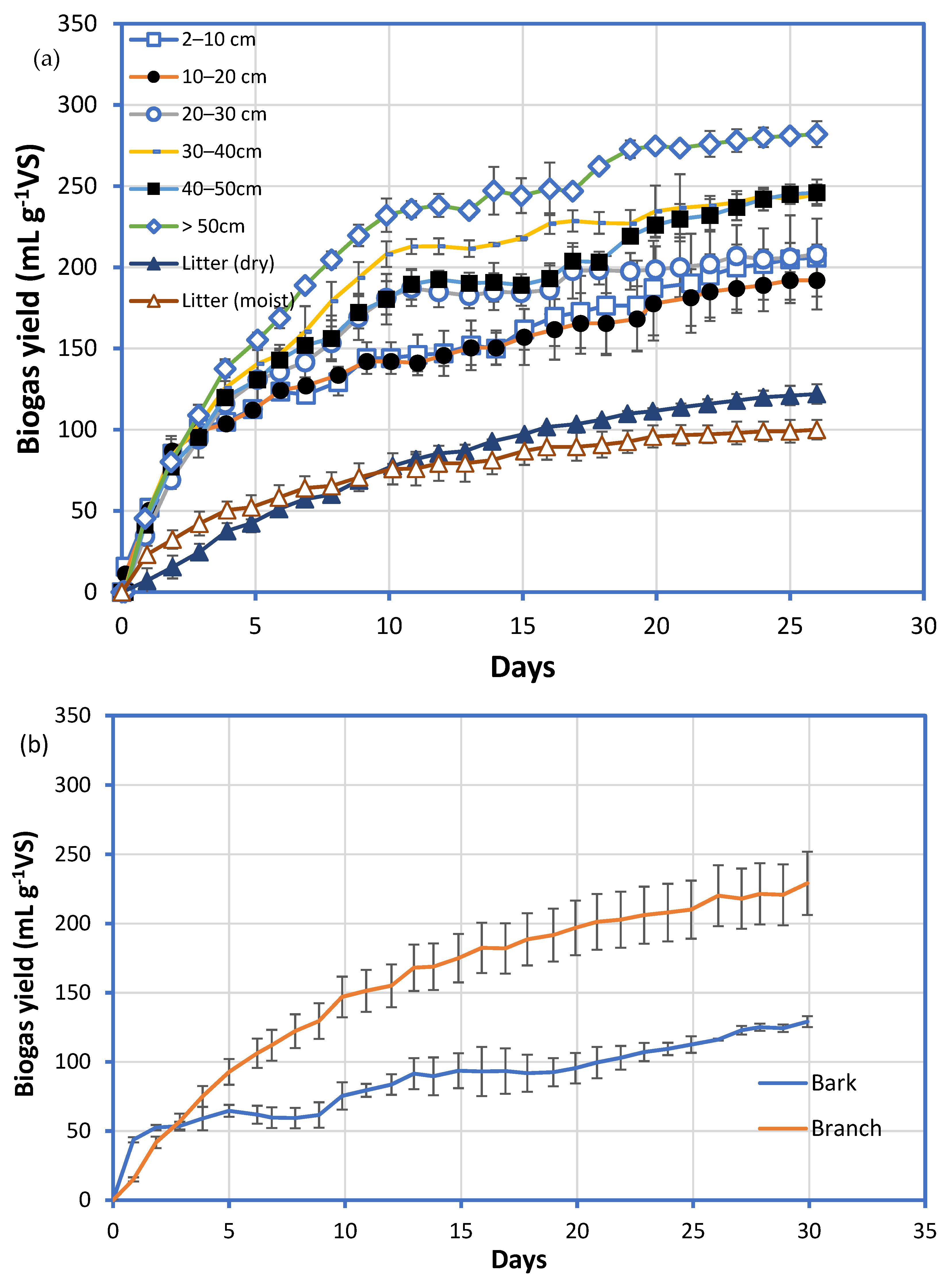
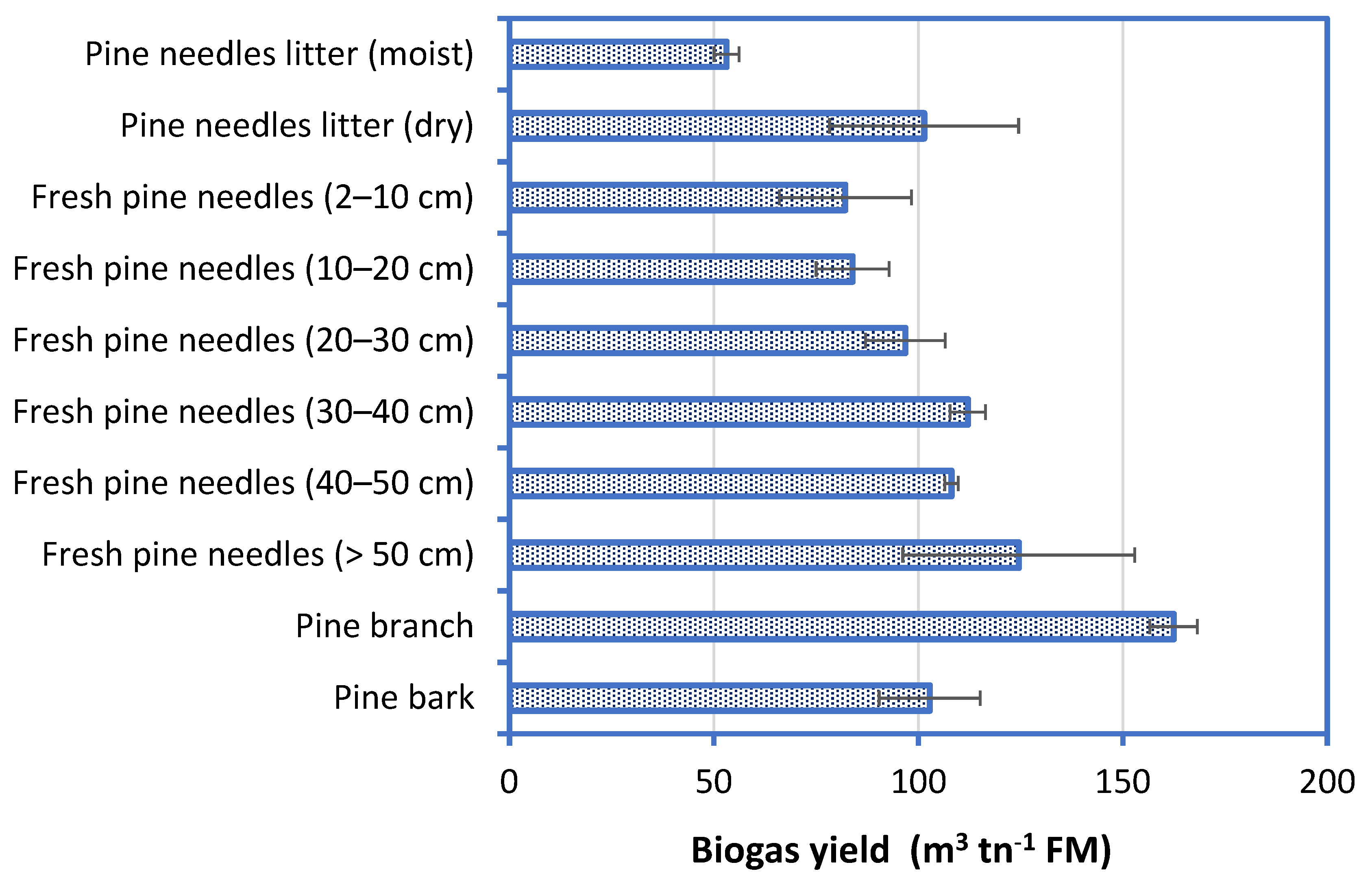
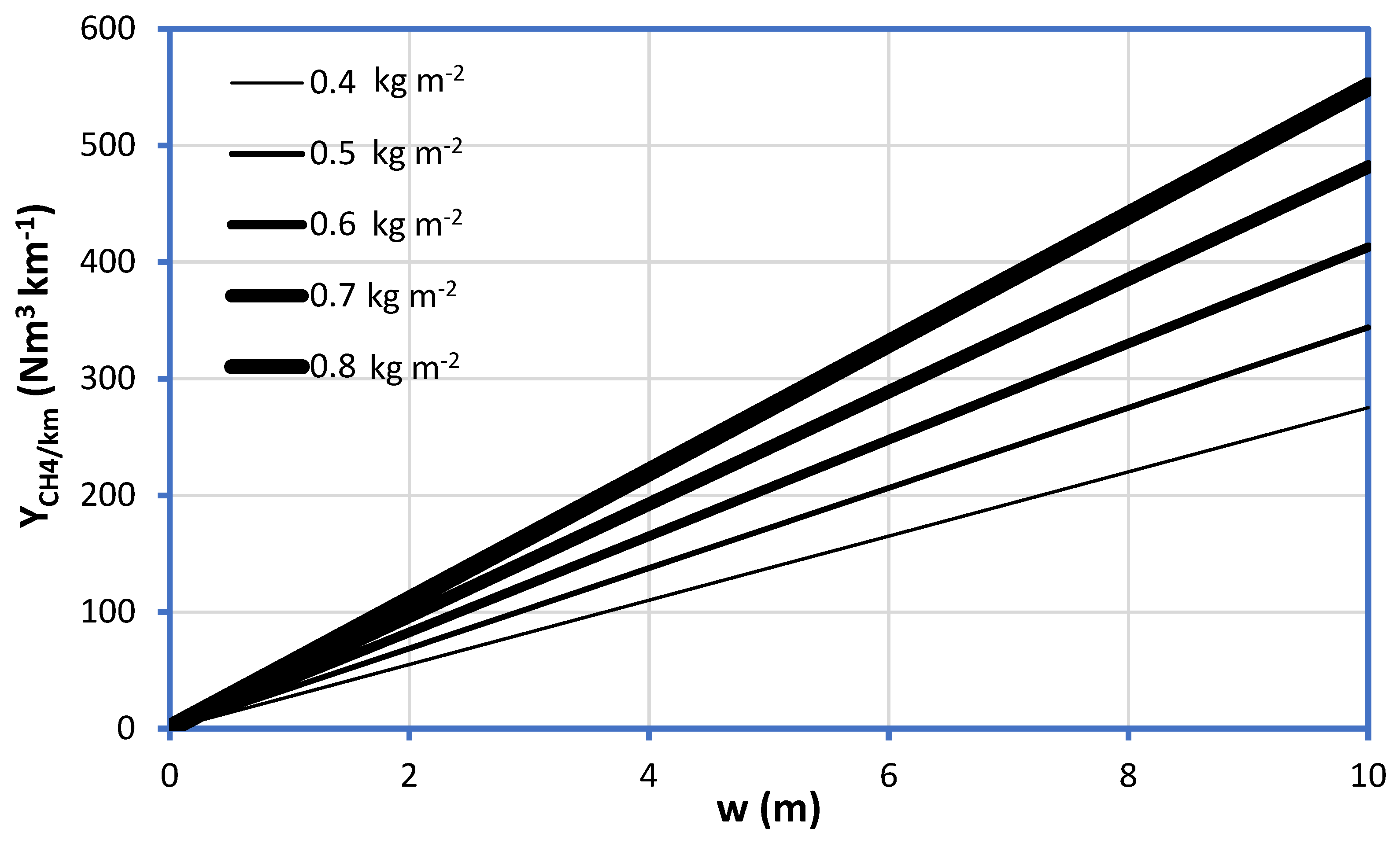
| Pine Tree Diameter (cm) | Moisture (% FM) | TS (g kg−1 FM) | VS (g kg−1 FM) | VS (% TS) | HEO (% VS) |
|---|---|---|---|---|---|
| Fresh pine needles | |||||
| <10 | 55.1 | 449 | 430 | 95.8 | 5.3 |
| 10–20 | 47.5 | 525 | 507 | 96.6 | 7.7 |
| 20–30 | 49.4 | 506 | 484 | 95.7 | 4.5 |
| 30–40 | 50.8 | 492 | 474 | 96.3 | 5.7 |
| 40–50 | 50.7 | 493 | 471 | 95.5 | 6.4 |
| >50 | 52.0 | 480 | 457 | 95.2 | 6.6 |
| Pine needle litter | |||||
| Dry litter | 11.5 | 885 | 863 | 97.5 | 2.7 |
| Moist litter | 42.9 | 571 | 539 | 94.4 | 3.0 |
| Pine branch | 22.7 | 773 | 730 | 94.4 | 5.5 |
| Pine bark | 16.5 | 835 | 822 | 98.4 | 7.8 |
| Pine Tree Diameter (cm) | K (d−1) | YCH4/VS (NmL g−1 VS) |
|---|---|---|
| Fresh pine needles | ||
| <10 | 0.085 | 130 (±24) |
| 10–20 | 0.098 | 115 (±18) |
| 20–30 | 0.103 | 128 (±6) |
| 30–40 | 0.110 | 145 (±6) |
| 40–50 | 0.092 | 150 (±8) |
| >50 | 0.117 | 164 (±8) |
| Pine needle litter | ||
| Dry litter | 0.080 | 77 (±6) |
| Moist litter | 0.121 | 58 (±6) |
| Pine branch | 0.074 | 138 (±35) |
| Pine bark | 0.071 | 85 (±4) |
| Sample | Pre-Treatment (Particle Size) | TS (% FM) | VS (% TS) | Digestion Time (d) | Temperature (°C) | BMP (NmL g−1 VS) | Reference |
|---|---|---|---|---|---|---|---|
| Yard waste | Drying and grinding (5–12 mm) | NR | 82.4 | 35 | 35 | 245 | [33] |
| Pine needles | Milling (<0.5 mm) | NR | NR | 45 | 37 | 213 | [17] |
| Pine needles | Milling (<0.5 mm) | NR | NR | 25 | 37 | 152 | [17] |
| Birch wood without bark | Drying and milling (<10 mm) | 92.9 | NR | 46 | 37 | 205 | [13] |
| Fresh fagus leaves | Grinding (<20 mm) | 45.3 | 94.4 | 30 | 38 | 158 | [12] |
| Fallen oak leaves | Grinding and milling (<2 mm) | 86.5 | 81.2 | 40 | 38 | 151 | [10] |
| Fallen leaves | Drying and milling (1–2 mm) | 87.1 | 96.4 | 30 | 36 | 134 | [9] |
| Phoenix tree leaves | Drying and pulverization (<0.8 mm) | NR | NR | 52 | 37 | 133 | [11] |
| Poplar wood processing waste | Milling (6–12 mm) | 84.8 | 91.2 | 70 | 35 | 100 | [14] |
| Fallen tree leaves | Drying and milling (<5 mm) | 90.0 | 86.9 | 30 | 37 | 81 | [15] |
| Fagus leaves litter | Grinding (<20 mm) | 89.5 | 82.0 | 30 | 38 | 80 | [12] |
| Poplar wood processing waste | Milling (6–12 mm) | 83.6 | 89.8 | 30 | 35 | 60 | [34] |
| Yard waste (leaves/tree branches) | Drying and milling (<5 mm) | 94.3 | 91.7 | 30 | 37 | 60 | [15] |
| Maple wood with bark | Drying and milling (<5 mm) | 93.0 | 90.5 | 30 | 37 | 57 | [15] |
| Pine wood with bark | Drying and milling (<5 mm) | 93.6 | 92.2 | 30 | 37 | 54 | [15] |
| Pine bark | Milling (size not reported) | NR | NR | 42 | 37 | 53 | [16] |
| Spruce bark | Milling (size not reported) | NR | NR | 42 | 37 | 46 | [16] |
| Pine branches | Milling (<0.5 mm) | NR | NR | 45 | 37 | 36 | [17] |
| Pine bark | Milling (<0.5 mm) | NR | NR | 45 | 37 | 33 | [17] |
| Pine branches | Milling (<10 mm) | 77.3 | 94.4 | 30 | 38 | 138 | This study |
| Fresh pine needles | Grinding (<10 mm) | 49.1 | 95.9 | 26 | 38 | 115–164 | This study |
| Pine bark | Milling (<10 mm) | 83.5 | 98.4 | 30 | 38 | 85 | This study |
| Pine needle litter | Grinding (<10 mm) | 88.5 | 97.5 | 26 | 38 | 58–77 | This study |
Publisher’s Note: MDPI stays neutral with regard to jurisdictional claims in published maps and institutional affiliations. |
© 2022 by the authors. Licensee MDPI, Basel, Switzerland. This article is an open access article distributed under the terms and conditions of the Creative Commons Attribution (CC BY) license (https://creativecommons.org/licenses/by/4.0/).
Share and Cite
Eftaxias, A.; Passa, E.A.; Michailidis, C.; Daoutis, C.; Kantartzis, A.; Diamantis, V. Residual Forest Biomass in Pinus Stands: Accumulation and Biogas Production Potential. Energies 2022, 15, 5233. https://doi.org/10.3390/en15145233
Eftaxias A, Passa EA, Michailidis C, Daoutis C, Kantartzis A, Diamantis V. Residual Forest Biomass in Pinus Stands: Accumulation and Biogas Production Potential. Energies. 2022; 15(14):5233. https://doi.org/10.3390/en15145233
Chicago/Turabian StyleEftaxias, Alexandros, Evangelia Anna Passa, Christos Michailidis, Christodoulos Daoutis, Apostolos Kantartzis, and Vasileios Diamantis. 2022. "Residual Forest Biomass in Pinus Stands: Accumulation and Biogas Production Potential" Energies 15, no. 14: 5233. https://doi.org/10.3390/en15145233
APA StyleEftaxias, A., Passa, E. A., Michailidis, C., Daoutis, C., Kantartzis, A., & Diamantis, V. (2022). Residual Forest Biomass in Pinus Stands: Accumulation and Biogas Production Potential. Energies, 15(14), 5233. https://doi.org/10.3390/en15145233








